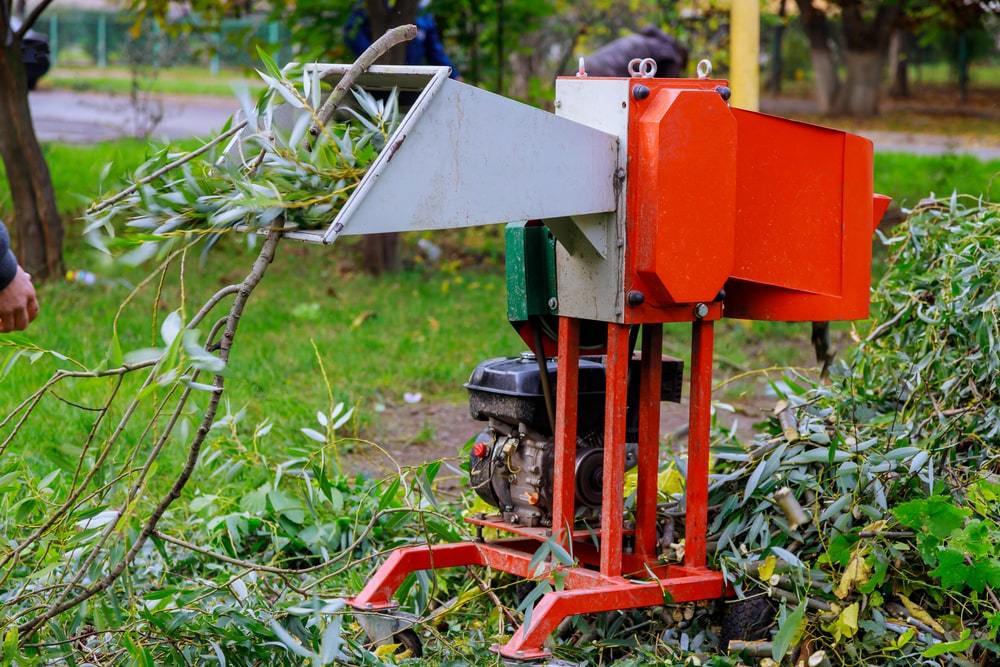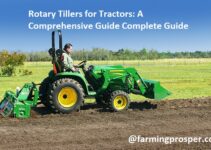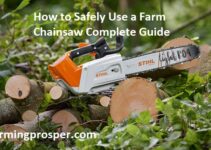Are you a farmer looking for the right commercial wood chipper? You want an efficient machine to make quick work of clearing your thicket?
This guide is here to help you pick the perfect machine for your needs. With the right selection, you can make light work of even the most densely forested areas.
Every commercial farming operation needs an effective wood chipper. This machine can make quick work of branches, saplings, limbs, and logs while turning them into manageable chips of wood in a fraction of the time it would take to do by hand. Choosing the right wood chipper for your farm is an important decision, as the wrong one could lead to wasted time and effort.
In this guide, we’ll provide an overview of the different types of wood chippers available and their unique features so that you can make an informed decision about which one is best suited for your needs. We will also discuss how you can maintain your machine to ensure that it provides trouble-free operation for years to come. So let’s get started!
Definition of Commercial Wood Chipper
A wood chipper, also known as a woodchipper, is a machine that reduces wood into small particles. It is usually used to produce chips for sawmills, biomass fuel, animal bedding and mulch for landscaping. Wood chippers come in different sizes and configurations depending on the application or intended use.
Used for commercial, agricultural and forestry functions, commercial-grade wood chippers are designed to quickly process large amounts of material with ease. The most common type of commercial chipper is the drum chipper. It uses blades mounted on a rotating drum to reduce the material into chips or pieces. Drum chippers are usually powered by electric motors or diesel engines and feature adjustable hoppers to target specific types of debris.
Commercial wood chip machines also come in various models that feature unique capabilities depending on the type of material they are meant to be used with. There are gravity feed models that are typically used with materials such as compost, leaves and grass clippings; gas-powered models used for branches and bushes; pneumatic models used with brush materials; hydraulic models best suited for large logs; industrial-grade machines that can handle extremely hardwoods like cedar; mulching chip machines that break down twigs and branches into small particles; band saws that use peeling blades to rip through larger logs fast; horizontal grinders often used in rigid waste processing facilities; heavy-duty mobile shredders equipped with Caterpillar tracks made for land clearing projects – the list goes on!

Importance of Choosing the Right Wood Chipper for Your Farm
Choosing the wrong wood chipper or tree shredder for your farm can lead to disappointment and wasted resources. Wood-chipping machines vary in size, power, design, and function. As such, it is important to understand these factors and select a machine according to your needs and preferences. With a wood chipper of the wrong size, you may end up with chunks of wood that are too large or small for what you have planned.
Apart from size, another important factor to consider when choosing a commercial wood chipper is its power source. Most models are powered by either gasoline or electricity; determine which power source is more cost-effective for your particular operation. As for design features, there are both contractor and homemade versions available on the market so it pays to research each type before making your decision. Think about the job you need your machine to do; will it be used only occasionally or regularly? Answering these questions will help you make an informed decision when selecting a commerical wood chipper for your farm.
Features to Consider
When selecting a wood chipper, it is important to consider a few features. The first is the type of material you’ll be chipping: is it hardwood or softwood? Chippers typically use different sized bits, depending on the material being chipped. Additionally, make sure the chipper you choose can handle branches up to the size you’ll need it for. Some machines have adjustable blades so that larger pieces can be accommodated by extending its capacity. If needed, some bigger models offer the option of hydraulically powered feeding systems which make feeding wood into your wood chipper much easier.
Another key feature to consider when looking at commercial wood chippers is safety. Make sure your machine has a locking device so that no one can operate the machine while another person is in the vicinity and check to see if it has emergency stops that are easy to access as well as guarding over moving parts. Lastly, consider looking into a newer model with an automatic shut-off that will power down after each use, saving energy and extending its lifespan by preventing unnecessary wear and tear on internal components.
Engine Size and Power
When choosing a commercial wood chipper, it’s important to select one with an engine that can handle the job at hand. The size of your land and the type of material you will be chipping will help you determine how much power is required. For light duty yard work, a 9hp motor may suffice, but for heavy-duty farming applications, you’ll need bigger equipment with motors up to 24hp or more.
You should also look for a durable belt system to ensure reliable power transfer from the engine to the knife mechanism. Safety features such as anti-kickback bars are also crucial due to the risky nature of this job. Make sure you look for a model that meets local safety standards and comes with comprehensive operator training plans.
Feed System
The feed system of a commercial wood chipper is the method in which the logs are loaded into the machine for processing. The design and setup of each feed system will vary depending on the type, size, and power of the machine. The three most common types are manual, hydraulic, and gravity-fed.
Manual Feed systems consist of a crank or lever-operated system that uses friction to grasp onto a log and pull it into the machine with continual force. This slow process can be labor intensive but is often preferred because it allows you to get a more accurate size variety than other feed systems can provide.
Hydraulic Feed systems are usually found in larger machines that have robust internal motors that use pressurized fluid or oil to do most of the work required in loading logs into the machine. This prevents breakage associated with manual feeds while still allowing you to control size variation.
Gravity-fed Feed Systems involve an inclined ramp leading up to an open end at which point logs roll easily down towards a cutting device at the bottom created by two thick blades lined up one on top of another in alternate directions, giving a much larger capacity for logs at any given time than alternative methods can provide.
Chipping Capacity
One of the most important aspects to consider before choosing a commercial wood chipper is its chipping capacity. The chipping capacity will determine the size and type of tree, as well as the diameter size and number of branches that can be processed by the machine.
The capacity of a commercial wood chipper is usually measured in kilowatts (kW) or horsepower (HP). Generally, the larger the machine, the larger its capacity. A powerful machine with a large capacity, such as those found in forestry operations, may range from 15 to 75 kW or from 20 to 100 HP.
Some machines are designed for multiple functions, allowing operators to perform both cross-cutting and chipping operations with a higher degree of accuracy. For small farms and homesteads, compact machines ranging from 3 to 7 kW or 4 to 10 HP may be a more suitable choice.
You should also consider whether your wood chipper will be stationary or mobile. Stationary machines are ideal for larger log sizes while mobile models make it easier to transport smaller logs around your property without much effort.
Portability and Maneuverability
Portability and maneuverability are important considerations when looking for a commercial wood chipper. If you plan to move the chipper around your property or between sites, portability is an important factor to consider. Generally, the lighter and smaller a chipper is, the more portable it will be. However, bear in mind that smaller chippers can have less power and features than their bulkier counterparts.
Manueuverability is also an important consideration; look out for features such as adjustable handlebars, reverse gear, low ground clearance and all-wheel drive – all of which allow for easier operation in difficult or tight spaces. A good maneuverable chipper should also provide good stability even when running at full capacity. Make sure you buy one with enough weight to ensure it stays grounded while it’s chewing up branches and logs so that it won’t slide around on slick surfaces.
In addition, be sure to select a model with features such as removable side panels for easy access to your chipper’s key components for cleaning, maintenance and repairs.

Safety Features
When purchasing a commercial wood chipper, it is essential to take into account all aspects of safety. At the minimum, this will include understanding what the machine can and cannot handle and taking proper protective measures when operating the machine.
Prior to purchasing a commercial wood chipper, it is important to consult with a local sales expert about the types of materials that can be safely fed into the machine, as well as understand what sort of features and technology are provided with the model. A few key safety features to look at when evaluating a safe design are emergency stops to turn off power quickly, gravity-fed hoppers that feed material from above, emergency shut-offs positioned near rotating blades or parts, heavy duty grates for debris shielding and chip deflectors for keeping material along established travel pathways.
Additionally, some models feature two separate control systems for starting and stopping for added protection in hazardous situations. It’s also important to invest in guards over moving components such as rollers or conveyors; these guards help keep employees safe while they’re in close proximity or working around them.
Maintenance and Care
Maintaining your commercial wood chipper is essential to ensure that it operates correctly and functions at its peak efficiency. Regularly scheduled maintenance inspections will help to identify potential issues before they become costly repairs. A well-maintained commercial wood chipper can last for many years and save you money in the long run.
When it comes to maintenance, there are two main lines of care for your chipper—preventative and curative. Preventative maintenance involves inspecting the components of your machine on a regular basis, such as belts, pulleys and blades, in order to make sure that they are in good condition and functioning properly. Curative maintenance addresses issues with parts or systems that have already started showing signs of wear or damage.
When it comes time to perform either type of maintenance on your machine, it is important to remember basic safety precautions, such as wearing the proper protective gear like safety glasses when dealing with sharp blades and disabled the power source before performing any inspections or repairs on your machine. Additionally, some routine service tasks should always be handled by a qualified technician who is trained in industrial machine upkeep. These more complex tasks can include changing engine oil levels and replacing spark plugs, inspection parts for damage or wear (such as belts), repairing cracked pulleys or worn bushings, or other more advanced operations performed by a professional technician.
Cleaning and Maintenance Schedule
Creating a cleaning and maintenance schedule for your commercial wood chipper will help ensure that it runs more efficiently and longer.
Routinely inspect the machine’s blades, wheels and cutting mechanism as they are subject to wear and tear. Also, regularly check the hammer blades, flywheels, intake ports, screens, deflectors and safety guards for damage.
Clean out any vegetation or debris which may have built up inside or along the grinders or blades. Finally, top up all fluids such as motor oil and hydraulic oil to prevent overheating or engine failure.
Troubleshooting Tips
When it comes to choosing the right commercial-grade wood chipper for your farm, there are a few troubleshooting tips that can help ensure that you make the best purchase. For instance, part of the research you should be doing is to compare different models and brands on the market. It’s important to read customer reviews and find out which model has been proven to last longest and perform best. Once you’ve narrowed down your choices, consider the following tips:
- Review your requirements – Make sure that the commercial-grade wood chipper will meet all of your needs, such as size and capacity. Also pay attention to any features offered by different models so you can evaluate which one is best suited for your farm operations.
- Assess build quality – Look closely at how well manufactured each wood chipper is and verify materials used, warranty periods offered as well as after sales service terms.
- Consider portability – If you need to move your wood chipper frequently, look for one with a compact design that can be moved easily without having to disassemble it completely or needing an extra vehicle or machinery for transport. Tires must have durable treads that won’t easily wear out while relocating between job sites.
- Evaluate noise levels – Commercial grade wood chips produce noise pollution when in operation so make sure you select a model with appropriate noise reduction gear fitted or capable of being fitted over time as this will ensure better workplace safety and reduce public disturbance from nearby residents if applicable
- Calculate power needs – Check power requirements of potential purchases against what is available in terms of an existing power supply onsite or whether additional generators are necessary and if these are included in any package deals being offered.
Common Maintenance Issues
Regular maintenance is necessary to keep your commercial wood chipper working properly and efficiently. Common maintenance issues to be aware of include sharpening or replacing chipper blades, checking the belt systems, inspecting bearings, and keeping an eye on the safety systems.
Sharpening or Replacing Blades: The knives and chipper blades of a wood chipper are essential for efficient operation. Working with any knife-based tool requires proper sharpening or replacement when worn out. It is important to regularly check the blades of a wood chipper for top performance as dull blades cause more wear and tear on the machine.
Checking Belt Systems: The belt system is responsible for operating most components on a wood chipper including hoppers, bins, drum units, the blade drive shafts and motors. Regularly checking tension on belts can help prevent damage caused by breakage and wear-and-tear over time from poor tensioning. When adjusting belts always ensure they are properly adjusted according to manufacturer specifications; failure to do so may result in serious injury or even death if not done correctly.
Inspect Bearings: Machine bearings need regular inspection to ensure they are free from vibration damage caused by worn parts failing due to age or mishandling during operation of the machine itself. All bearings should be checked to ensure that they are free from debris buildup, especially around the internal components such as seals, balls and races which could affect performance over time if not addressed quickly and efficiently.
Safety Systems: Safety systems play an important role in preventing accidents when operating any piece of heavy machinery like a wood chipper. It’s important to look out for warning signs such as excessive noise coming from moving parts like belts or fans, indicator lights going off due to faulty start switches/motor protection devices etc., disconnected guard guards/shields around machines which may lead to injury etc., Visually inspect different areas of your commercial wood chippers periodically; this helps identify problems before they cause serious incidents at work sites where large numbers of personnel may be present at any given time who could potentially get injured in case something fails while running during production times – possibly leading to costly financial penalties being imposed on business owners if laws regarding health & safely regulations are violated during normal operations (e.g. power driven machinery).

Conclusion
Selecting the right commercial wood chipper for your farm requires knowledge of your specific needs. Choosing the best industrial wood chipper can be a daunting task, but it doesn’t have to be if you take the time to do the research. Consider features such as capacity, power source, engine size, and safety features like anti-kickback devices. You should also look at warranty options and after-sales service guarantees when selecting a commercial wood chipper to make sure you’re making a smart choice.
With all this information in mind, you should now be better prepared to select the perfect wood chipper for your property needs.
FAQ
How do I choose a wood chipper?
You should consider factors such as the size of the branches you will be chipping, the power source, the type of blades, and the capacity of the chipper.
What must be considered when deciding what wood chipper model is needed?
You should consider the size of the branches you will be chipping, the power source, the type of blades, the capacity of the chipper, and the frequency of use.
What size wood chipper should I get?
The size of the wood chipper you need depends on the size of the branches you will be chipping. A general rule of thumb is to choose a chipper that can handle branches up to 3 inches in diameter.
What to look for when buying a used chipper?
You should inspect the blades, engine, and overall condition of the chipper. It’s also important to ask about the chipper’s maintenance history and any previous repairs.
How much HP does a wood chipper need?
The amount of horsepower a wood chipper needs depends on the size of the branches you will be chipping. A chipper with 10-15 horsepower is typically sufficient for branches up to 3 inches in diameter.
What is the difference between a chipper and a chipper shredder?
A chipper is designed to only chip branches and other woody debris, while a chipper shredder can also shred leaves and other yard waste.
What is better drum or disc on wood chipper?
Both drum and disc chippers have their advantages and disadvantages. Drum chippers are better for chipping larger branches, while disc chippers are better for chipping smaller branches and producing a finer mulch.
What makes a good chipper?
A good chipper should have a powerful engine, sharp blades, a large capacity, and be easy to use and maintain.
What is the difference between a wood chipper and a wood mulcher?
A wood chipper is designed to chip branches and other woody debris into small pieces, while a wood mulcher is designed to shred leaves and other yard waste into a fine mulch.
What are the different types of chipper?
The different types of chipper include electric, gas-powered, PTO-driven, and hydraulic. They can also be classified as drum or disc chippers.
See Also :
- Best chicken coops for 6 chickens 2023
- Best chicken plucker 2023
- Best chicken waterer 2023
- Best clippers for goats 2023
- Best commercial wood chipper 2023


